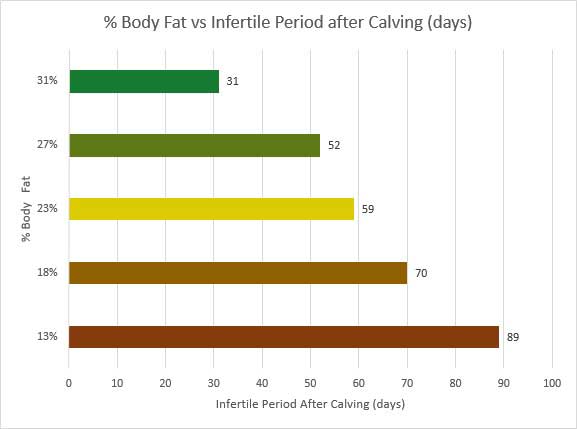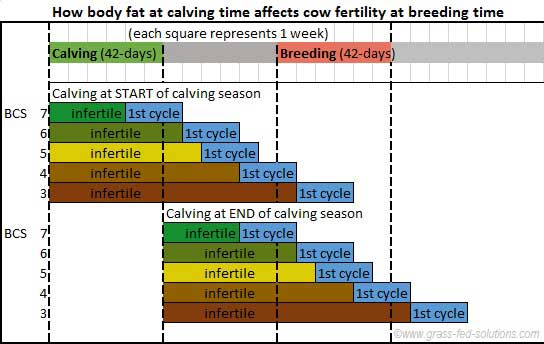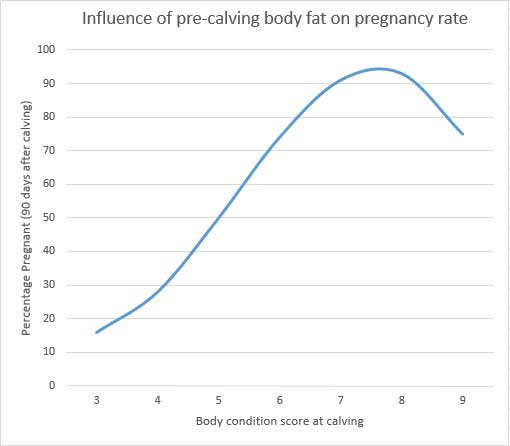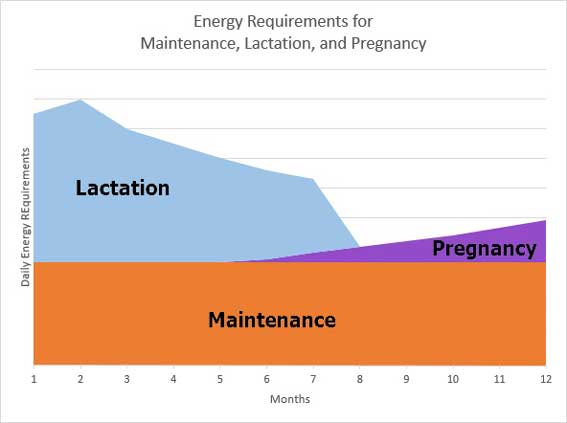In case you have a cow-calf herd, you understand how vital cattle fertility is to your farm’s survival. What if I informed you that there’s a highly effective software that permits you to dramatically enhance conception charges in your herd whereas lowering manufacturing prices on the identical time? And it is utterly pure. It is your cows’ physique fats at calving time.
It most likely does not come as a shock {that a} half-starved cow goes to battle to get pregnant. However what’s a shock is that physique fats at calving time has a far higher affect on conception charges than physique fats at breeding time. And it is also a shock how a lot of a distinction even small adjustments in physique fats at calving time can have on conception charges.
So on this article I’m going to discover this highly effective correlation between physique fats at calving time and fertility at breeding time. And I’ll share some administration adjustments you can also make in your farm to benefit from this highly effective correlation so you possibly can improve conception charges in your herd whereas lowering your manufacturing prices on the identical time!
Physique fats throughout calving season trumps physique fats throughout the breeding season.
Cattle fertility does not simply bounce again instantly after calving. Cows usually are not immediately fertile once more as quickly as their calves hit the bottom.
After calving there’s an infertile interval whereas the cow’s physique recovers from her being pregnant and begins getting ready for her subsequent breeding cycle. This infertile interval, from the day of calving till the day the cows expertise their first estrus cycle (or first warmth), known as the postpartum interval.
And the size of this infertile interval will depend on how a lot physique fats the cow has when she calves.
Many individuals mistakenly consider that fertility and conception charges at breeding time rely upon how a lot physique fats a cow has throughout the breeding season. Whereas this definitely performs a small position, it’s a lot much less vital than how a lot physique fats a cow has at calving time!
The chart under reveals how physique fats impacts the size of this infertile interval after calving (1). As you possibly can see, the distinction is fairly vital!
 The size of the infertile interval after calving will depend on how a lot physique fats a cow has at calving time.
The size of the infertile interval after calving will depend on how a lot physique fats a cow has at calving time.
For these readers accustomed to working with body condition scores, 13% physique fats corresponds to a Physique Situation Rating of three (very skinny) on the 9-point scale, 18% is a BCS of 4 (skinny), 23% is a BCS of 5 (average), 27% is a BCS of 6 (good), and 31% is a BCS of seven (superb) (2,3).
So let’s put these numbers into context as a result of they’ve big implications for the conception charges in your cow-calf herd and in your total beef manufacturing prices.
The size of the infertile interval after calving impacts conception charges
Within the chart under I’ve superimposed these infertile durations on a cow-calf manufacturing calendar with a 42-day calving season. You will discover that I’ve finished it twice – as soon as for the cows that calve early and once more for the cows that calve late within the calving season.
 Cattle manufacturing calendar displaying the infertile interval and 1st estrus cycle of cows that calve at the start versus the top of the calving interval.
Cattle manufacturing calendar displaying the infertile interval and 1st estrus cycle of cows that calve at the start versus the top of the calving interval.
Earlier than I dissect this chart I might like to say why I’ve tacked on the first estrus cycle (in blue) on the finish of the infertile durations proven on the chart.
A cow can conceive throughout the first estrus cycle after calving. However her fertility remains to be lower than splendid throughout this 1st estrus cycle so her probability of a profitable being pregnant is considerably decrease. The primary cycle is sort of a mock run to get the cow’s system up and working once more. Conception charges are a lot greater within the subsequent cycle.
So if you wish to maximize conception charges in your cattle herd, breeding shouldn’t begin till after the complete infertile interval AND the primary estrus cycle.
Now again to the earlier chart of the calving/breeding schedule. A fast look on the second group of cow (the late calvers) reveals the place the issue lies in having skinny cows at calving time. They simply do not have sufficient time to recuperate prior to start out of the breeding season.
The truth is, even the fattest cows which have the shortest infertile interval after calving nonetheless have lower than splendid fertility throughout a portion of the breeding season in the event that they calve late within the season. Late-calving cows which are solely modestly skinny at calving have just about no probability of rebreeding and the thinnest cows haven’t any probability of conceiving in any respect. They will not even cycle but whereas they’re with the bulls!
And this state of affairs is utilizing the really useful 42-day breeding season, which permits every cow two full estrus cycles to get pregnant whereas they’re with the bulls. With an extended 60-day or 90-day calving season (not really useful), the late calving cows can be in much more bother!
Physique fats vs conception charges
This subsequent chart turns all this info into an much more placing image. It reveals the being pregnant price of cattle 90 days after calving relying on how fats they’re at calving time (4).
 The impact of physique fats at calving time on the chance of being pregnant 90 days after calving
The impact of physique fats at calving time on the chance of being pregnant 90 days after calving
That is fairly a spread of conception charges, from 15% for cows with a physique situation rating of three to properly over 90% for cows with a physique situation rating of seven!
The apparent lesson from all that is that in order for you your cows to rebreed simply, be certain that they’re good and fats when calving season begins. Not too fats (fertility goes again down as soon as cattle get overweight), however fats sufficient to maximise fertility and conception charges.
However that’s not the top of the story.
Gaining weight at calving time is vital
There’s one other twist. To ensure that cows to realize the being pregnant charges proven within the earlier graph additionally they should be gaining weight simply earlier than they calve!
Even when cows have splendid physique fats ranges at calving time, if they’re utilizing up a few of that physique fats to make up for a calorie deficiency within the days earlier than they calve then they won’t conceive as simply. The easy motive: shedding weight earlier than calving extends the time that cows stay infertile after calving simply as if they’d much less physique fats to start with (5).
From an evolutionary standpoint it is sensible. Physique fats is a implausible set off to make sure that the cow has sufficient vitality reserves to handle herself, her new calf, and likewise get pregnant once more.
If physique fats at calving time is low then poor fertility compromises the longer term being pregnant in order that the cow has a greater probability of taking good care of her calf and herself with out including the vitality drain of one other being pregnant. And even when physique fats ranges are excessive, if her physique fats reserves are getting used (she’s not gaining weight) at calving time, then that is an indication that meals assets are dwindling, so once more it’s advantageous to scale back fertility to guard herself and her present calf.
Why physique fats at breeding time is much less vital.
You could be tempted to assume that in case your cows are just a little lean or dropping a little bit of weight at calving time you possibly can rescue their fertility by making certain that they’re good and fats when breeding season begins.
Mistaken. Sadly this would possibly not save the day. This is why:
To begin with, the countdown on the infertile interval after calving begins when the calf hits the bottom. You’ll be able to’t retroactively reset the clock.
It’s true that physique fats at breeding time makes a distinction. If the cows have misplaced extra physique fats, this can additional scale back their fertility, thus successfully slowing the clock nonetheless additional. However what if the cows acquire weight and improve their physique fats reserves by the point breeding begins – will that velocity up the clock and shorten the infertile interval?
The issue with attempting to hurry up the clock is that cattle our bodies prioritize how they expend their vitality. First they handle their very own upkeep wants. Then they handle producing sufficient milk for his or her present calf. And provided that all these wants are met will any further energy be accessible for weight acquire.
Whereas a cow is pregnant she will nonetheless acquire weight pretty simply. The being pregnant takes some further vitality, however not a lot that she can’t placed on some physique fats too. However as soon as a cow calves her vitality stability adjustments utterly. Producing milk takes an enormous quantity of vitality! Consuming sufficient energy to realize physique fats whereas lactating is sort of unattainable.
The chart under reveals how the vitality necessities for upkeep, milk manufacturing and being pregnant evaluate:
 Cow vitality necessities (upkeep, lactation, and being pregnant) over a 12-month interval. In the event you additionally need the cow to realize weight you will must feed much more energy!
Cow vitality necessities (upkeep, lactation, and being pregnant) over a 12-month interval. In the event you additionally need the cow to realize weight you will must feed much more energy!
As you possibly can see, the energy (vitality) required to supply milk are monumental – far past these required throughout being pregnant. And the additional energy required for weight beneficial properties need to be added to these required for upkeep plus lactation or being pregnant.
Feeding cows sufficient meals to allow them to produce sufficient milk for his or her calves plus additionally acquire weight on the identical time requires such a high-calorie eating regimen that it’s practically unattainable to do. In actuality, cows are more likely to barely keep and even lose just a little little bit of physique fats as soon as lactation begins, even on a main lush pasture or on prime quality feed.
Until your cows poop pure gold, feeding them sufficient energy to supply milk plus acquire weight themselves is totally and utterly unprofitable.
The problem of maximizing conception charges and minimizing feed prices in a standard spring calving season
Most cattle farmers use a spring calving season. What this truly means is that they calve earlier than the rising season begins.
This places them right into a tough balancing act. On the one hand they wish to maximize their cows’ physique fats at calving time so their herd can re-breed efficiently. Alternatively, ensuring the cows are fats after a protracted winter takes a whole lot of cattle feed and that will get costly.
In order that they need to strike a stability. They goal to have their cows in good situation at calving season, however solely goal for a physique situation rating of 6 on the 9-point scale – an equal of 27% physique fats. They do not hand over an excessive amount of fertility versus having them at a physique situation rating of seven – sufficient cows nonetheless handle to rebreed to maintain herd numbers steady – however additionally they do not need to feed a lot costly winter feed to make their enterprise unprofitable.
It really works – form of – but it surely’s not a recipe for low-cost cow-calf manufacturing. Retaining their cows at a physique situation rating of 6 means they can’t enable their cows to lose any weight over the winter. Which implies that they can’t afford to proceed grazing low cost winter pastures whose high quality is slowly deteriorating due to the wind, rain, and snow. They merely can’t afford to let cows drop to a physique situation rating of 5 earlier than they calve. Low-cost winter pastures are out. They haven’t any selection however to stay with costly high-calorie winter feed.
However there’s an one other technique that reduces winter feed prices, permits cattle to fatten up cheaply earlier than they calve, supplies all of the energy required for lactation, will increase fertility and conception charges, and will not value you a dime in further cattle feed!
Calving throughout the rising season – the key to low-cost cow-calf manufacturing
Let’s shift the timing of the calving season just a bit bit to see what occurs.
Think about the cattle herd begins calving 4 to six weeks AFTER the rising season begins. These cows face a very totally different scenario than cows which calve earlier than the rising season begins.
These cows have not less than 6 weeks to fatten up on prime, lush, low cost pasture earlier than they calve. As a result of they are not lactating but, even when they arrive out of the winter with a physique situation rating of 5, they’ve ample time and sufficiently low vitality wants to have the ability to fatten as much as a physique situation rating of seven earlier than they calve!
Elevated fertility with out the feed prices
A physique situation rating of seven at calving time means their infertile interval after calving will likely be a lot shorter. Conception charges will due to this fact be a lot greater than in a standard spring calving herd. And you will not have spent a fortune on winter feed to realize these excessive conception charges!
Tighter calving seasons
There’s such a lift to cattle fertility whenever you change to calving throughout the rising season {that a} a lot higher variety of cows will calve throughout the first half of the calving season as a result of they catch on the primary breeding cycle! This makes for a way more uniform calf crop.
Decrease alternative heifer prices
Greater conception charges additionally imply that you will want much less alternative heifers to take care of your herd measurement. You’ll be able to afford to cull all cows that had calving difficulties or whose calves obtained sick anytime between calving and weaning. Meaning solely the perfect genetics will make it into your brood herd and you will have extra extra heifers that may be offered, which will increase your farm’s backside line.
Pasture-supported milk manufacturing
Milk manufacturing definitely is not compromised by this calving schedule both. Calving 4 to six weeks into the rising season implies that the cows nonetheless have many of the summer season forward of them to supply ample milk for his or her calves.
More healthy calves, extra colostrum, and extra milk
The advantages of summer season calving additionally extends to the calves. Calves born on pasture are inclined to have much less illness points – small surprise when the climate is heat and dry and they’re surrounded by a sea of recent grass as an alternative of mud and dirty bedding piles.
There’s additionally an enormous enhance to calf efficiency. Extra physique fats at calving time causes cows to supply extra colostrum for his or her calves (6). It isn’t simply your creativeness that pasture-born calves are extra vigorous!
And that enhance in efficiency does not finish when the colostrum runs out. Cows with extra physique fats at calving time produce extra milk for his or her calves over the following 4 months (7). So the calves will develop quicker simply because the cows have greater physique fats after they calve!
Longer winter grazing seasons on low cost winter pastures
Calving throughout the rising season reduces your winter feed prices in a number of methods.
As a result of the cows have time to fatten up on spring pastures earlier than they calve, they are often coasted by means of the winter on fewer energy than in case you are attempting to maintain cows in prime situation all winter. They’ll even use a little bit of their physique fats to complement themselves. So whereas your cows are on winter feed they will want much less of it to get by.
However if you happen to grasp the ability of winter grazing you will even have a shorter feeding season to take care of. As a result of the cows can progressively lose a little bit of physique fats throughout the winter (right down to a physique situation rating of 5) they’ll spend portion of the winter grazing on low cost frozen pastures. They need not change to costly winter feed as early as cows that calve earlier than the rising season begins.
How lengthy you possibly can proceed grazing will depend on your potential to create high quality winter pastures and in your winter grazing skills. The longer you retain grazing, the decrease your feed prices. Some farmers hone their expertise to such a level that they’ll efficiently graze frozen winter pastures proper by means of the entire winter, even through deep snow.
Compensatory Achieve
In the event you’ve learn my article about compensatory gain, you understand how effectively cattle can acquire weight after a interval of weight reduction. It is all due to how their metabolisms decelerate to compensate for calorie-shortages and the delayed metabolic response after the interval of weight reduction ends.
Cows that finish the winter at a physique situation rating of 5 will expertise this compensatory acquire when they’re set free onto spring pastures, permitting them to realize weight extraordinarily effectively. That is a part of the key why they’re able to bounce again as much as a physique situation rating of seven earlier than calving after solely 4 to six weeks of grazing on a high-calorie spring pasture.
Delayed weaning
In the event you’re calving throughout the rising season, there’s additionally no rush to wean within the fall. Different producers wean earlier than they change to their winter feed program to allow them to hold their cows from shedding weight with out spending a fortune on feed.
However if you happen to calve throughout the rising season, letting the cows hold producing milk throughout the winter will not damage your backside line because it’s okay in the event that they lose just a little weight. The truth is, as I clarify in my guide, Grass Fed Cattle: how to produce and market natural beef, there are a whole lot of advantages to delaying weaning for so long as attainable so the calves can acquire just a little further weight from their mom’s milk. As winter pasture high quality declines, many cows will wean their calves on their very own.
And a strong alternate calf advertising and marketing technique
Delayed weaning additionally suggests another advertising and marketing state of affairs that permits you to produce as a lot beef as attainable on low cost summer season pastures.
By weaning as late as attainable the cows successfully coast the calves by means of the winter very cheaply by supplementing them with just a little further milk. The longer you delay weaning, the longer the calves get that further little little bit of milk. So long as you monitor your cows physique situation to make sure that their physique fats reserves stay inside protected ranges (do not allow them to drop under a physique situation rating of 5 on the 9-point scale), you possibly can let the calves stick with the cows all winter.
You’ll be able to wean as late as 4 to six weeks earlier than the following calving season, simply as pastures begin to inexperienced up, although many producers that graze proper by means of the winter will wean just a little earlier in an effort to stop cow physique situation scores from dropping under a BCS of 5.
In early spring you then benefit from compensatory acquire to fatten these calves by yourself pastures after which both promote them as lengthy yearlings in late summer season or grass end them your self within the fall if you happen to want. Both approach, your value of manufacturing is way a lot decrease as a result of the vast majority of these beneficial properties had been produced on pasture and never in a winter feed pen. And by protecting calves longer, you want much less cows to supply the identical quantity of beef every year. Much less cows means even decrease winter feed prices and extra pasture accessible for fattening extra calves.
And all due to just a little tweaking in your timing so you possibly can match your cattle’s vitality must the grass in your pastures!
…
In the event you’ve discovered this text helpful, please share it with three different farmers that you recognize – I respect your assist in rising my viewers! And when you’ve got questions or feedback, please share them under or join with me on social media.
If you would like to be notified once I launch future cattle farming articles, join my email notifications or observe me on Facebook or Twitter.
- Houghton, P.L., R.P. Lemenager, L.A.Horstman, Okay.S. Hendrix and G.E. Moss. 1990. Results of physique composition, pre- and postpartum vitality degree and early weaning on reproductive efficiency of beef cows ans preweaning calf acquire. J. Anim. Sci. 68:1438-1446.
- Fox, D.G., C.J. Sniffen and J.D. O’Connor. 1988. Adjusting Nutrient Necessities of Beef Cattle For Animal and Environmental Variations. J. Anim. Sci. 66:1475-1495.
- Wagner, j.j., Okay.S. Lusby, J.W. Oltjen, J. Rakestraw, R.P. Wettemann and L.E. Walters. 1988. Carcass composition in mature Hereford cows: Estimation and impact on each day metabolizable vitality requirement throughout winter. J. Anim. Sci. 66: 603.
- SELK, G.E., R.P. Wettemann, Okay.S. Lusby, J.W. Oltjen, S.L. Mobley, R.J. Rasby and J.C. Garmendia. 1988. Relationships amongst weight change, physique situation and reproductive efficiency of vary beef cows. J. Anim. Sci. 66: 3153.
- Lahman, D.L., D.H. Keisler, J.E. Williams, E.J. Scholljegerdes and D.M. Mallet. 1997. Affect of postpartum weight and physique situation change on length of anestrus by undernourished suckled beef heifers. J. Anim. Sci. 75: 2003-2008.
- Odde, Okay.G. 1997. Reproductive effectivity, precalving vitamin, and enhancing calf survival. Proc. Bovine Connection, 860-092.
- Domecq, J.J., A.L. Skidmore, J.W. Lloyd, and J.B. Kaneene. 1997. Relationship Between Physique Situation Scores and Milk Yield in a Giant Dairy Herd of Excessive Yielding Holstein Cows. J. Dairy Science. 80: 101-112
Trending Merchandise

ZuPreem FruitBlend Bird Pellets, Daily Bird F...

ZuPreem Sensible Seed Bird Food, Parakeet, Bu...

Kaytee Forti-Diet Egg-Cite Parakeet Pet Bird ...

Best Nest Wellness Mama Bird Probiotics ̵...

Kaytee Fiesta Macaw Food, Nutritious and Fun ...

Pet Eye Cream Health for Dogs, Cats, Cattle, ...





